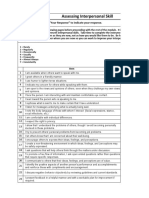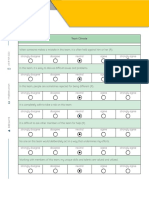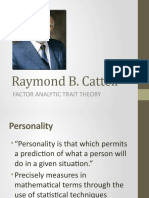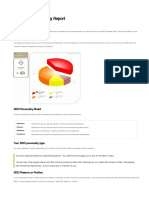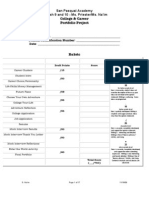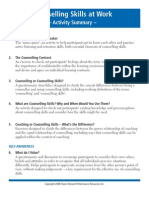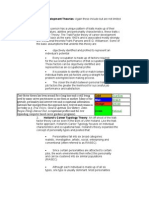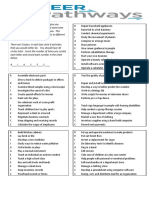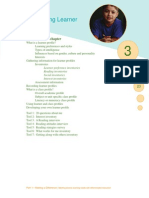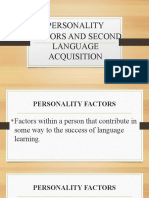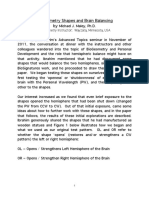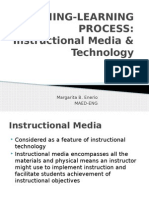Comm Self Assessment
Comm Self Assessment
Uploaded by
Kevin CoolCopyright:
Available Formats
Comm Self Assessment
Comm Self Assessment
Uploaded by
Kevin CoolOriginal Description:
Copyright
Available Formats
Share this document
Did you find this document useful?
Is this content inappropriate?
Copyright:
Available Formats
Comm Self Assessment
Comm Self Assessment
Uploaded by
Kevin CoolCopyright:
Available Formats
Communication Styles: A Self-Assessment Exercise
(Based on the work of P Case Teaching for the Cross-Cultural Mind Washington, DC, SIETAR, 1981) Instructions: Please select from each pair of attributes the one which is most typical of your personality. No pair is an either-or proposal. Make your choice as spontaneously as possible. There is no wrong answer. 1. I like action. 2. I deal with problems in a systematic way. 3. I believe that teams are more effective than individuals. 4. I enjoy innovation very much. 5. I am more interested in the future than in the past. 6. I enjoy working with people. 7. I like to attend well-organized group meetings. 8. Deadlines are important for me. 9. I cannot stand procrastination. 10. I believe that new ideas have to be tested before being used. 11. I enjoy the stimulation of interaction with others. 12. I am always looking for new possibilities. 13. I want to set up my own objectives. 14. When I start something, I go through until the end. 15. I basically try to understand other peoples emotions. 16. I do challenge people around me. 17. I look forward to receiving feedback on my performance. 18. I find the step-by-step approach very effective. 19. I think I am good at reading people. 20. I like creative problem solving. 21. I extrapolate and project all the time. 22. I am sensitive to others needs. 23. Planning is the key to success. 24. I become impatient with long deliberations. 25. I am cool under pressure. 26. I value experience very much. 27. I listen to people.
28. People say that I am a fast thinker. 29. Cooperation is a key word for me. 30. I use logical methods to test alternatives. 31. I like to handle several projects at the same time. 32. I always question myself. 33. I learn by doing. 34. I believe that my head rules my heart. 35. I can predict how others may react to a certain action. 36. I do not like details. 37. Analysis should always precede action. 38. I am able to assess the climate of a group. 39. I have a tendency to start things and not finish them up. 40. I perceive myself as decisive. 41. I search for challenging tasks. 42. I rely on observation and data. 43. I can express my feelings openly. 44. I like to design new projects. 45. I enjoy reading very much. 46. I perceive myself as a facilitator. 47. I like to focus on one issue at a time. 48. I like to achieve. 49. I enjoy learning about others. 50. I like variety. 51. Facts speak for themselves. 52. I use my imagination as much as possible. 53. I am impatient with long, slow assignments. 54. My mind never stops working. 55. Key decisions have to be made in a cautious way. 56. I strongly believe that people need each other to get work done. 57. I usually make decisions without thinking too much. 58. Emotions create problems. 59. I like to be liked by others. 60. I can put two and two together very quickly. 61. I try out my new ideas on people.
62. I believe in the scientific approach. 63. I like to get things done. 64. Good relationships are essential. 65. I am impulsive. 66. I accept differences in people. 67. Communicating with people is an end in itself. 68. I like to be intellectually stimulated. 69. I like to organize. 70. I usually jump from one task to another. 71. Talking and working with people is a creative art. 72. Self-actualization is a key word for me. 73. I enjoy playing with ideas. 74. I dislike wasting my time. 75. I enjoy doing what I am good at. 76. I learn by interacting with others. 77. I find abstractions interesting and enjoyable. 78. I am patient with details. 79. I like brief, to the point statements. 80. I feel confident in myself.
Scoring Sheet for the Communication Styles Assessment Instructions: Circle the items you have selected and add up the totals for each style (one point per answer). The maximum is 20 per style and your total for the four styles should be 40. Style Style 1 1 - 8 - 9 - 13 - 17 - 24 - 26 - 31 - 33 - 40 - 41 48 - 50 - 53 - 57 - 63 - 65 - 70 - 74 - 79 Style 2 2 - 7 - 10 - 14 - 18 - 23 - 25 - 30 - 34 - 37 - 42 47 - 51 - 55 - 58 - 62 - 66 - 69 - 75 - 78 Style 3 3 - 6 - 11 - 15 - 19 - 22 - 27 - 29 - 35 - 38 - 43 46 - 49 - 56 - 59 - 64 - 67 - 71 - 76 - 80 Style 4 4 - 5 - 12 - 16 - 20 - 21 - 28 - 32 - 36 - 39 - 44 45 - 52 - 54 - 60 - 61 - 68 - 72 - 73 77 ____________ ____________ ____________ Circle your answer here Total Score (max. 20)
____________
The Four Communication Styles Style 1: WHAT ACTION (A) Results Objectives Achieving Doing Style 4: WHY IDEA (I) Concepts Theories Innovation Style 2: HOW PROCESS (PR) Strategies Organization Facts Style 3: WHO PEOPLE (PE) Communication Relationships Teamwork
The Main Characteristics of Communication Styles Style Action (A) Content people with this style talk about Results Objectives Performance Productivity Efficiency Moving ahead Process (PR) Decisions Facts Procedures Planning Organizing Controlling Testing People Needs Motivation Teamwork Communications Feelings Team spirit Understanding Concepts Innovation Interdependence New ways New methods Improving Problems Responsibility Feedback Experience Challenges Achievements Change Trying out Analysis Observations Proof Details Cautious Self-development Sensitivity Awareness Cooperation Beliefs Values Expectations Relations Whats new in the field Creativity Opportunities Possibilities Grand designs Issues Potential Alternatives Process people with this style are Pragmatic (down to earth) Direct (to the point) Impatient Decisive Quick (jump from idea to idea) Energetic (challenge others) Systematic (stepby-step) Logical (cause and effect) Factual Verbose Unemotional Patient Spontaneous Empathetic Warm Subjective Emotional Perceptive Sensitive Imaginative Charismatic Difficult to understand Ego-centered Unrealistic Creative Full of ideas Provocative
People (PE)
Idea (I)
Adjusting to Other Communication Styles Communicating with an Action (A) oriented person: Focus on the result first; state the conclusion at the outset. State your best recommendation; do not offer many alternatives. Be as brief as possible. Emphasize the practicality of your ideas. Use visual aids.
Communicating with a Process (PR) oriented person: Be precise; state the facts. Organize your discussion in a logical order: o Background o Present situation o Outcome Break down your recommendations. Include options and alternatives with pros and cons. Do not rush a process-oriented person. Outline your proposal.
Communicating with a People (PE) oriented person: Allow for small talk; do not start the discussion right away. Stress the relationship between your proposal and the people concerned. Show how the idea worked well in the past. Indicate support from well-respected people. Use an informal writing style.
Communicating with an Idea (I) oriented person: Allow enough time for discussion. Do not get impatient when he or she goes off on tangents. Try to relate the discussed topic to a broader concept or idea Stress the uniqueness of the idea or topic at hand. Emphasize future value or relate the impact of the idea to the future. If writing, try to stress the key concepts that underlie your recommendation at the outset. Start with an overall statement and work toward the particulars.
You might also like
- Communication Styles Assessment ESAIDocument5 pagesCommunication Styles Assessment ESAI6mqj8cem4100% (3)
- Motivation and Career Anchors AssessmentDocument9 pagesMotivation and Career Anchors Assessmentmishrapoem007_854030100% (1)
- Fundamental Interpersonal Relations Orientation-Behavior (FIRO-B)Document3 pagesFundamental Interpersonal Relations Orientation-Behavior (FIRO-B)Virendra KumarNo ratings yet
- Emotional Intelligence NotesDocument24 pagesEmotional Intelligence NotesFatima Malik80% (5)
- PA Personality InventoryDocument11 pagesPA Personality InventoryFany Tiara IndahNo ratings yet
- Leadership Practices Inventory: Response Scale 1 - Very Rarely 2 - Rarely 3 - Sometimes 4 - Mostly 5 - Almost AlwaysDocument2 pagesLeadership Practices Inventory: Response Scale 1 - Very Rarely 2 - Rarely 3 - Sometimes 4 - Mostly 5 - Almost AlwaysAbdisa BiraNo ratings yet
- Interpersonal Skill AssessmentDocument6 pagesInterpersonal Skill AssessmentKaty DNo ratings yet
- ETC Webinar Communication Styles AssessmentDocument5 pagesETC Webinar Communication Styles AssessmentCorina IcaNo ratings yet
- DiscselfsamplereportDocument38 pagesDiscselfsamplereportapi-280199986No ratings yet
- Reflective Exercise 4 My Self-Assessment With Swot AnalysisDocument11 pagesReflective Exercise 4 My Self-Assessment With Swot Analysisapi-407839349No ratings yet
- Belbin's Team ModelDocument2 pagesBelbin's Team Modelsonu_saisNo ratings yet
- Parker Team Player For Grad StudentsDocument23 pagesParker Team Player For Grad StudentsRavnish Wesley100% (2)
- How Emotionally Intelligent Are YouDocument3 pagesHow Emotionally Intelligent Are YouMaximilian DramescuNo ratings yet
- Drivers Working Styles Questionairre and SummaryDocument5 pagesDrivers Working Styles Questionairre and SummaryCosmina LungeanuNo ratings yet
- DISC QuestionnaireDocument1 pageDISC QuestionnaireJohn Ben Faustino Rodriguez100% (2)
- Communication Styles AssessmentDocument6 pagesCommunication Styles AssessmentLeandro Bondad100% (1)
- Comm Styles Survey & NotesDocument11 pagesComm Styles Survey & NotesBiran HeNo ratings yet
- Psychological Safety QuestionnaireDocument3 pagesPsychological Safety QuestionnaireFarrah MalaNo ratings yet
- Learning Styles Questionnaire Short Version Aug10Document3 pagesLearning Styles Questionnaire Short Version Aug10api-267898429100% (1)
- Personality Assessment - Carreer TestDocument7 pagesPersonality Assessment - Carreer TestboranscribdNo ratings yet
- CSP 621 Growth Mindset Lesson PlanDocument4 pagesCSP 621 Growth Mindset Lesson Planapi-548723359No ratings yet
- Assessment Work ValuesDocument3 pagesAssessment Work ValuesRamyLloydLotillaNo ratings yet
- U1 Career Anchors AssessmentDocument9 pagesU1 Career Anchors Assessmentapi-545984709No ratings yet
- FIRO-B Interpretive Report For OrganizationsDocument13 pagesFIRO-B Interpretive Report For OrganizationsSandip Kumar RamjiNo ratings yet
- Transactional Analysis QuestionnaireDocument7 pagesTransactional Analysis QuestionnaireMegha GuptaNo ratings yet
- Basic Counseling Skills in IrlwDocument9 pagesBasic Counseling Skills in Irlwthilaga2009No ratings yet
- Stress - Personality Styles and EIDocument24 pagesStress - Personality Styles and EICheri Ho100% (1)
- Raymond B. Cattell: Factor Analytic Trait TheoryDocument16 pagesRaymond B. Cattell: Factor Analytic Trait Theorykatb100% (1)
- Commerce 2ba3 Organizational Behaviour: Class 9 Conflict and Stress Dr. Christa WilkinDocument44 pagesCommerce 2ba3 Organizational Behaviour: Class 9 Conflict and Stress Dr. Christa WilkinakhilNo ratings yet
- Conflict Management QuestionnaireDocument2 pagesConflict Management QuestionnaireNarvinLallsaroop50% (2)
- Strengths Insight and Action-Planning Guide - Gallup OnlineDocument19 pagesStrengths Insight and Action-Planning Guide - Gallup OnlineJill GoughNo ratings yet
- Leadership AssessmentDocument2 pagesLeadership AssessmentSAMRIDDHI SAHUNo ratings yet
- Career Guidance ReportDocument14 pagesCareer Guidance ReportArushi SinghNo ratings yet
- Belbin InventoryDocument8 pagesBelbin InventoryOsemhen Akhibi100% (1)
- DiscDocument3 pagesDiscapi-523050935No ratings yet
- Understanding Emotional Intelligence& Conflict Resolution: Facilitator Gulzar KhalfanDocument27 pagesUnderstanding Emotional Intelligence& Conflict Resolution: Facilitator Gulzar KhalfanParag ShrivastavaNo ratings yet
- Emotional Intelligence Self-AssessmentDocument6 pagesEmotional Intelligence Self-AssessmentSehar Andleeb100% (2)
- Emotional Intelligence AssessmentDocument4 pagesEmotional Intelligence AssessmentCristina Madalina100% (1)
- Procedure - Test of Learning and Thinking StyleDocument5 pagesProcedure - Test of Learning and Thinking StyleArwa BoltwalaNo ratings yet
- Belbin's Team Roles - Lec 4Document5 pagesBelbin's Team Roles - Lec 4Tharushi DiyanaNo ratings yet
- College & Career PortfolioDocument17 pagesCollege & Career PortfoliodaaiyahnaimNo ratings yet
- Career Orientation QuestionnaireDocument8 pagesCareer Orientation QuestionnaireGorga SimamoraNo ratings yet
- Generations at WorkDocument27 pagesGenerations at WorkSheena HarrienNo ratings yet
- Counselling Skills at Work: - Activity SummaryDocument4 pagesCounselling Skills at Work: - Activity SummaryPriyanka Bhatia100% (1)
- Emotional Intelligence Digital Workbook - Class VersionDocument38 pagesEmotional Intelligence Digital Workbook - Class VersionmanickajaminNo ratings yet
- Career Counseling HODocument6 pagesCareer Counseling HOmaiquizNo ratings yet
- Career Pathways SurveyDocument2 pagesCareer Pathways SurveyTom Prescott0% (1)
- 01 NLD - AbovePlant - Workbook - Final - 24 JanDocument49 pages01 NLD - AbovePlant - Workbook - Final - 24 JanIulian BarbuNo ratings yet
- Learning Styles Questionnaire Honey and Mumford11Document10 pagesLearning Styles Questionnaire Honey and Mumford11Zeeshan AamirNo ratings yet
- Organizational Conflict QuestionnaireDocument2 pagesOrganizational Conflict Questionnaireapi-562040967100% (1)
- Class Reading - Belbin's Team Role TheoryDocument2 pagesClass Reading - Belbin's Team Role TheoryKashaf KhanNo ratings yet
- 6.08 Career Planning and Career DevelopmentDocument33 pages6.08 Career Planning and Career DevelopmentShimanta Easin100% (1)
- Name - Age - Yearlevel - Adversity Response ProfileDocument6 pagesName - Age - Yearlevel - Adversity Response ProfileMary Ann Austria Gonda-FelipeNo ratings yet
- Values Work Sheet Jan '11Document2 pagesValues Work Sheet Jan '11SupportNo ratings yet
- Self Esteem AssessmentDocument2 pagesSelf Esteem AssessmentswathiNo ratings yet
- Collaborative Problem Solving Group A Complete Guide - 2020 EditionFrom EverandCollaborative Problem Solving Group A Complete Guide - 2020 EditionNo ratings yet
- Make It Stick: The Science of Successful LearningDocument2 pagesMake It Stick: The Science of Successful LearningElloNo ratings yet
- 6 ch3 LearnerDocument22 pages6 ch3 Learnerapi-172952819No ratings yet
- Personality Factors and Second Language AcquisitionDocument61 pagesPersonality Factors and Second Language AcquisitionJoselitoQuintanaNo ratings yet
- Important Tips To Attempt English Reading Comprehension QuestionsDocument3 pagesImportant Tips To Attempt English Reading Comprehension QuestionsAzhar HussainNo ratings yet
- PSYC 3013 Lec Social Perception and Social Cognition Sem 2 20202021Document6 pagesPSYC 3013 Lec Social Perception and Social Cognition Sem 2 20202021Destina WarnerNo ratings yet
- Lesson Plan 5 Senses 2Document6 pagesLesson Plan 5 Senses 2Maith 2510100% (1)
- Emotional IntelligenceDocument6 pagesEmotional IntelligencePoorva PatilNo ratings yet
- Benefits of Teaching Poetry - Why Teach PoetryDocument3 pagesBenefits of Teaching Poetry - Why Teach Poetryapi-2932149310% (1)
- In-Text CitationDocument6 pagesIn-Text CitationDennis TecsonNo ratings yet
- Principles of Teaching 1 ReviewerDocument7 pagesPrinciples of Teaching 1 ReviewerErickMartinJohnson100% (8)
- Factors Affecting Listening SkillsDocument9 pagesFactors Affecting Listening SkillsHulk Hijau100% (1)
- Unit 3-Focus On Learning: Module OverviewDocument6 pagesUnit 3-Focus On Learning: Module OverviewJed GarciaNo ratings yet
- Signature PedagogyDocument9 pagesSignature Pedagogyapi-534924709No ratings yet
- Module 1 - The LearnerDocument15 pagesModule 1 - The LearnerFlorvie Mae Zarsata CulminasNo ratings yet
- Concept MapDocument6 pagesConcept Mapapi-3725139No ratings yet
- Unit 1. Human EmotionsDocument3 pagesUnit 1. Human EmotionsJoe Faustino100% (1)
- TFM Upna - Ruiz de Erenchun LizarragaDocument70 pagesTFM Upna - Ruiz de Erenchun Lizarragaxana_sweetNo ratings yet
- Learning To Be A Better StudentDocument15 pagesLearning To Be A Better StudentMika Lavado100% (1)
- Unpacking and Combining of Most Essential Learning Competencies Into Learning ObjectivesDocument1 pageUnpacking and Combining of Most Essential Learning Competencies Into Learning ObjectivesMariepet Acantilado Cristuta-AgustinesNo ratings yet
- Body Mirror: Genesis D. OraaDocument14 pagesBody Mirror: Genesis D. OraaGenesis Dela CruzNo ratings yet
- The Silent Limping Body of PhilosophyDocument35 pagesThe Silent Limping Body of PhilosophyPusilanNo ratings yet
- L6a Analyzing Consumer MarketsDocument41 pagesL6a Analyzing Consumer MarketsAshish kumar ThapaNo ratings yet
- BioGeometry Shapes and Brain BalancingDocument13 pagesBioGeometry Shapes and Brain Balancingn13l13100% (15)
- Cognitive Film Semiotics PDFDocument18 pagesCognitive Film Semiotics PDFFarih NourreNo ratings yet
- Why You're Pretty Much Unconscious All The TimeDocument3 pagesWhy You're Pretty Much Unconscious All The Timeferdyguma0% (1)
- BAPCH-bpcc101-102 2020-2021Document4 pagesBAPCH-bpcc101-102 2020-2021MarcoNo ratings yet
- DEPRESSION (Anaya Singh)Document16 pagesDEPRESSION (Anaya Singh)Arasshjit SandhuNo ratings yet
- Teaching-Learning Process - Instructional Media & TechnologyDocument10 pagesTeaching-Learning Process - Instructional Media & Technologyapi-286093222No ratings yet
- Tune Into ReadingDocument2 pagesTune Into Readingapi-492129988No ratings yet







